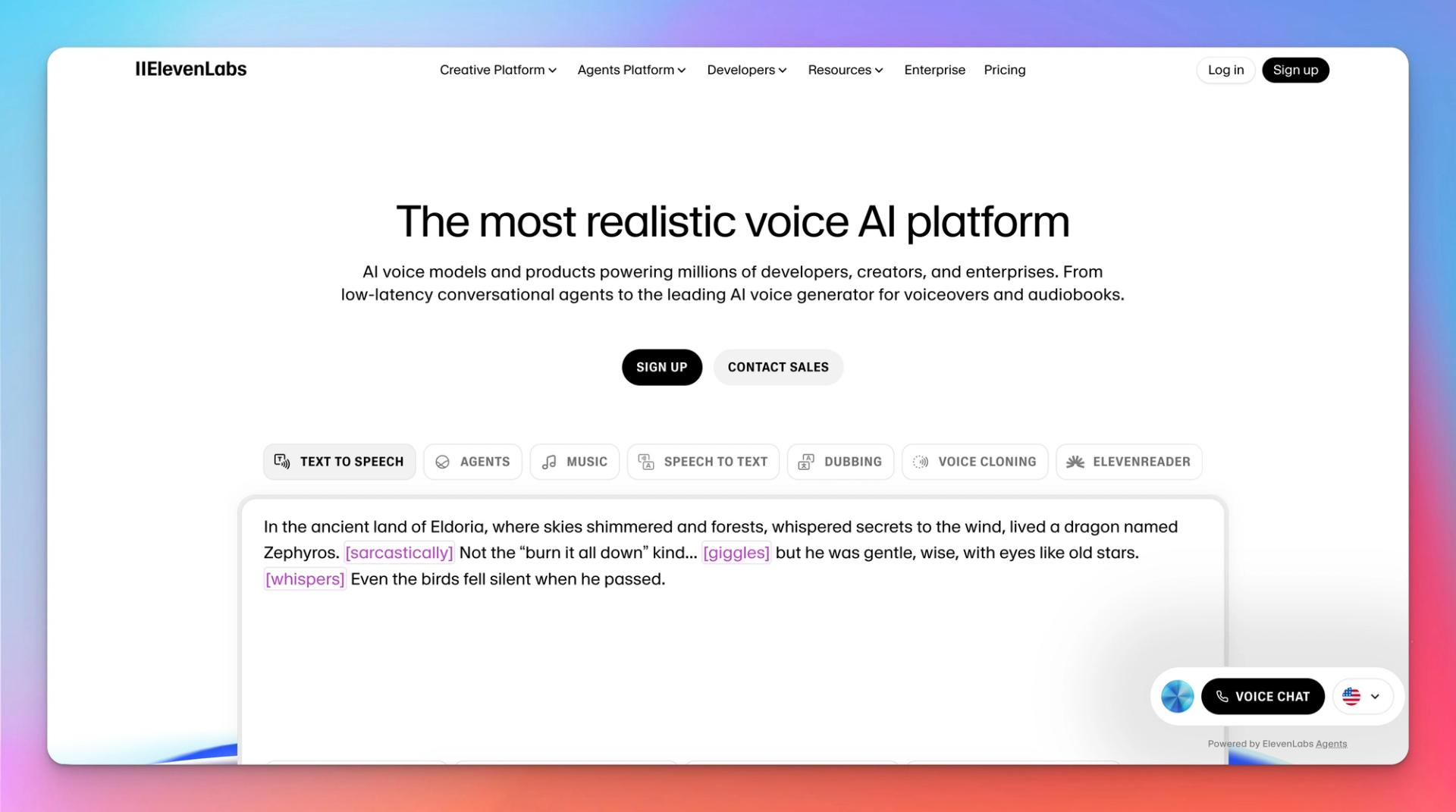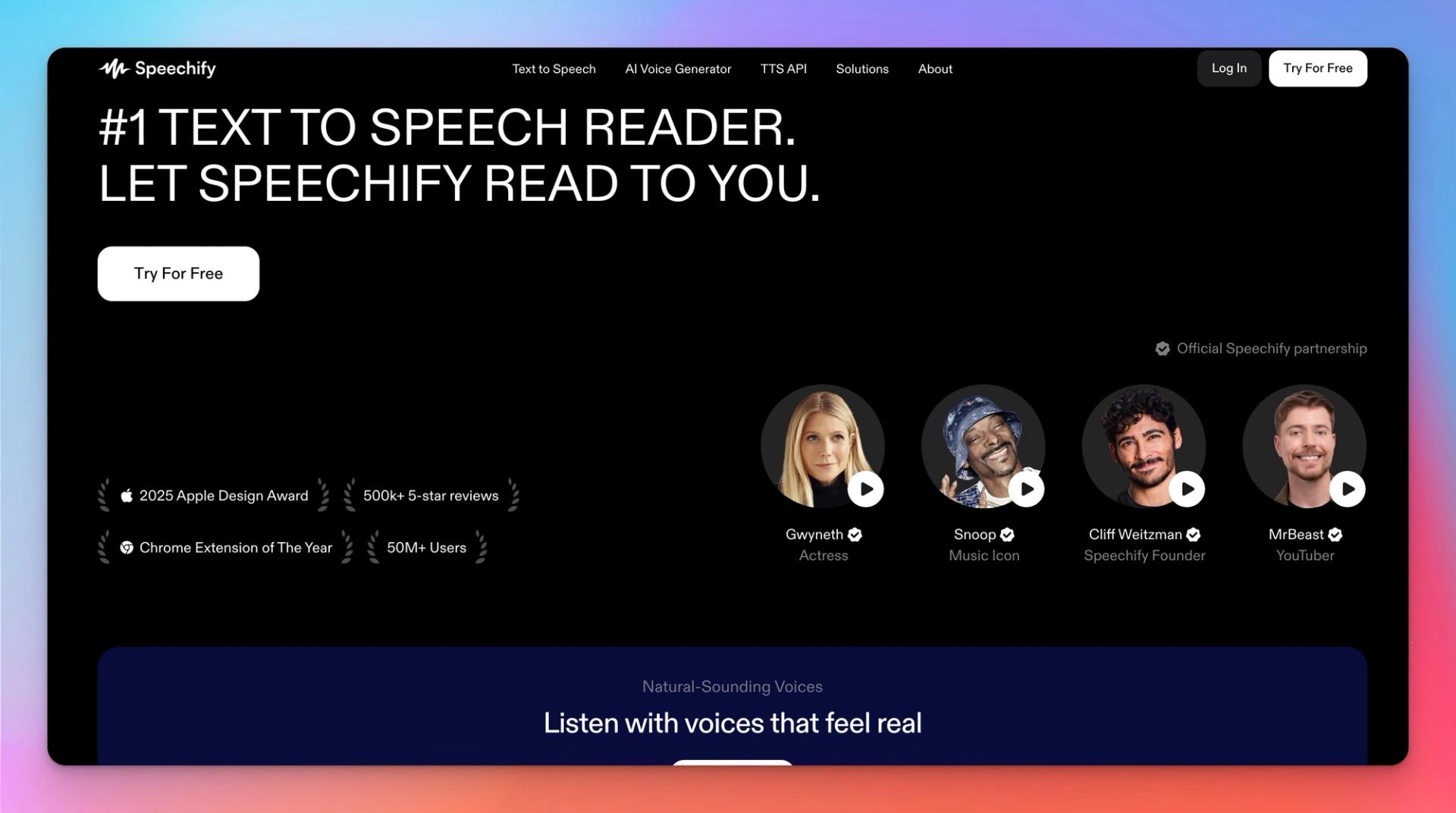Top 6 Murf AI Alternatives In 2025 (That Don’t Box You In)
If you’ve used Murf for more than a week, you already know its strengths: solid voices, okay editor, decent for explainer videos and training content. It’s the safe, middle-of-the-road choice.
But 2024–25 changed the game.
- Real-time voice for agents and live apps got good.
- Voice cloning went from toy to production.
- Tools like Play.ht started winding down and getting acquired, reminding everyone how risky vendor lock-in can be.
So if you’re a serious creator, marketer, or product team, you don’t want “okay”. You want:
- Voices that actually match your brand and emotion
- Pricing that doesn’t punish you for growth
- APIs and workflows that won’t fall apart the moment you ship something big
This breakdown looks at 6 Murf alternatives that actually solve different problems - with Listnr in the top spot for creators and teams who care about scale, multi-language, and reliable production voiceovers.
Quick list: best Murf AI alternatives in 2025
- Listnr AI – Scalable creator & team-friendly TTS studio
- ElevenLabs – Ultra-realistic voice cloning & storytelling
- Speechify – Reading assistant + accessibility focused
- Cartesia – Low-latency voice API for agents & live apps
- Lovo AI – Marketing/video-focused TTS + quick creative workflows
- WellSaid Labs – Enterprise training & compliance-centric narration
Why look beyond Murf in 2025?
Murf is still fine for a lot of people. It gives you:
- Decent quality voices
- A project-based editor
- Enough languages and accents to cover basic global use cases.
Where it starts to hurt:
- Cost at scale
Once you start doing real volumes (daily shorts, multiple languages, large course libraries), Murf’s pricing stops feeling “cheap” and starts feeling like another SaaS tax. - Emotion + flexibility
Murf is good, but other tools are now better at emotional range, conversational reads, or hyper-local multi-language voices. - Ecosystem
If you’re building around AI agents, live apps, or real-time experiences, Murf isn’t the most aggressive innovator in that direction.
So the question isn’t “Is Murf bad?”
It’s “Is Murf still the best for what you’re actually trying to do?”
Let’s walk through the 6 tools that often beat it, depending on your use case.
1. Listnr AI - Best overall Murf alternative for creators & teams

Listnr sits in a slightly different mindset than Murf. Murf still feels like “a tool for voiceovers”. Listnr is closer to “an AI voice and dubbing infrastructure layer” that happens to be friendly enough for solo creators.
You get 1,000+ voices across 142+ languages and accents, emotional styles, multi-voice conversations, and a studio that’s built for everything from Reels to full-length audiobooks.
What Listnr actually does well
- Wide, production-ready voice library
Listnr leans into breadth and depth: global accents, character-style voices, polished corporate reads, and more experimental options for social video. It’s built to handle Reels, YouTube videos, audiobooks, podcasts, and even IVR and agents from the same stack. - Serious control over delivery
You’re not locked into a “press button, get voice” flow. You can:- Adjust pitch, speed, emphasis, and pauses
- Use emotion-style controls to make reads [happy], [serious], [urgent], etc
- Build multi-speaker conversations inside a single timeline
This is where a lot of “Murf alternatives” fall apart; they sound nice, but you can’t get them to behave.
- End-to-end workflows beyond just audio
Listnr is wired into:- Short-form and long-form video workflows
- Podcast creation and distribution
- Dubbing and localization for existing content
- API use cases for dev teams running agents or custom apps.
If you’re someone who wants one stack that can do social, YouTube, podcasts, courses, and internal product voice - Listnr is built exactly for that.
Pricing snapshot
Listnr’s public pricing in late 2025:
- Individual - around $19/month (lower effective price on promos/annual)
- ~20,000 credits/month
- Solo - around $39/month
- Higher credit limits, more storage
- Higher tiers scale up words, storage, video exports, and cloning.
There’s also a free way to try it before committing.
Where it beats Murf
- More voices and more languages
- Better tuned for modern short-form content + multi-speaker projects
- Stronger focus on emotional nuance and fine control
- More flexible pricing at different creator scales
If you’re replacing Murf and want something that can grow with you - Listnr is the most straightforward upgrade.
2. ElevenLabs - Ultra-realistic voice cloning & storytelling

If your main pain point with Murf is “this still sounds a bit AI-ish in long-form storytelling”, ElevenLabs is usually the first place people look.
They built their brand on extremely realistic cloning and are now expanding into dubbing, music, and multi-modal audio.
Strengths
- Clones that actually feel like you
ElevenLabs lets you build voices that closely capture your natural cadence, tone, and quirks. For narrative podcasts, audiobooks, or creators who want “their voice in five languages”, it’s compelling. - Fast product velocity
They ship - a lot. Dubbing, music, real-time-ish experiences, and more advanced controls keep showing up inside their platform. - Enterprise and partner ecosystem
Deals with platforms like Spotify for AI audiobook narration give them a strong presence in publishing workflows.
Pricing snapshot
From public info and reviews in 2025:
- Free - 10k credits/month
- Starter - from $5/month (30k credits)
- Creator - around $11/month (100k credits)
- Pro - around $99/month (500k credits)
- Enterprise tiers scale much higher.
Credits are shared across TTS, dubbing, and sometimes agents depending on plan and model.
Where it beats Murf
- Most natural personal/cloned voices for long-form storytelling
- Strong dubbing + multi-language narration in higher tiers
- Good for authors, podcasters, game devs, and “character-driven” content
Where Murf or Listnr might still win
- For everyday “bulk production” voiceovers across many brands and languages, ElevenLabs can get expensive.
- UI and workflows are more power-user oriented; Murf and Listnr are often smoother for non-technical teams.
3. Speechify - Great for reading & education, not a full studio

Speechify isn’t really a “voiceover studio” competitor in the same way. It’s more of a reading assistant at scale: apps, browser extensions, and tools built around listening to content instead of staring at it.
Strengths
- Best-in-class for “read anything to me”
Upload PDFs, paste text, or browse the web - Speechify is optimised for consuming content while you commute, work out, or batch learn. - Solid language and voice coverage
1,000+ voices in 60+ languages is good enough for most reading-heavy workflows. - Huge adoption in education and accessibility
If you’re building for students, ADHD/reading difficulties, or corporate “learn on the go” experiences, users already recognise the brand.
Pricing snapshot
From public data in 2025:
- Free “limited” version
- Premium TTS - roughly $11.58/month when billed annually
- Monthly “full experience” pricing around $29/month in some regions
Where it beats Murf
- Better if your primary use case is reading and listening, not content production
- Stronger UX on mobile and personal devices
- Ideal companion tool if you’re writing scripts or courses and want to listen back
Where it falls short as a Murf replacement
- Not built as a full studio for exporting polished voiceovers
- Less granular control over emotion and pacing versus Murf or Listnr
- Not ideal if you’re producing branded social video or ads at scale
4. Cartesia - Low-latency voice for agents, bots, and live products
If your Murf usage is moving from “export MP3s” to “my product talks to users in real time”, Cartesia is the tool worth watching.
Cartesia is built around Ultra-low-latency voice models for agents, bots, and apps where speed matters more than timelines and timelines of audio editing.
Strengths
- Real-time performance
Response times in the 40–90 ms range make agent conversations feel far more natural than traditional TTS pipelines that buffer full sentences. - Developer-first design
You’re not given “a studio and a download button”. You get an API that plugs into your stack - perfect for call centers, live support agents, and conversational apps. - Modern pricing for programmatic volume
Usage-based pricing with credits is often cheaper when you’re doing lots of short, frequent interactions.
Pricing snapshot
From public pricing tables in 2025:
- Free - $0/month, 20,000 model credits
- Pro - around $4–5/month, 100,000 credits, instant cloning for commercial use
- Startup - around $39–49/month, ~1.25M credits and higher-quality cloning
- Scale - around $299/month, multi-million character volumes and priority support
Where it beats Murf
- Real-time conversations and live applications
- Fast, API-first integration for engineering teams
- Better fit for modern AI agents than a traditional “voiceover editor”
Where Murf/Listnr still win
- For non-technical creators who just want to upload a script and export an MP3 or video
- For content teams that care about studio UI, timelines, and multi-speaker editing
5. Lovo AI - Marketing and video-focused Murf alternative
Lovo aims to be the marketing team’s voice stack: templates, ad-focused reads, and an integrated video + TTS workflow rather than just raw audio export.
Strengths
- Good for ads, promos, and social videos
Lovo leans into expressive, punchy reads that perform well in short campaigns and brand content. - Integrated toolset
Beyond TTS, you get:- Simple video editor
- Auto subtitles
- Voice cloning and some creative tools (AI art, scripting, etc.)
- Mature library
500+ voices across ~100 languages is strong if your main use case is short-form content rather than deep localization.
Pricing snapshot
2025 reviews and comparison sites show:
- Basic - around $24–29/month
- Pro - often in the $48/month range
- Pro+ - higher tiers around $75–149/month depending on billing and export limits
- Free trial available with limited minutes.
Where it beats Murf
- Better pre-baked workflows for ad creatives and social video
- Video + audio combo inside one tool for small teams
- Expressive voices tuned more for “scroll-stopping” content
Where you need to be careful
- Some users and reviews complain about pricing versus value and business practices at certain tiers, so you’ll want to test it and read recent reviews before committing long term.
If you’re a scrappy marketing team needing quick campaigns, Lovo can work. If you’re building long-term infrastructure, Listnr, Murf, or Cartesia might be safer.
6. WellSaid Labs - Corporate training & compliance-heavy orgs
WellSaid Labs targets enterprises: training teams, internal communications, regulated industries. Think “polished corporate narration” over “TikTok hook”.
Strengths
- Very clean, neutral voices
WellSaid is strong at studio-quality voices that sound like professional voice actors doing e-learning and onboarding content. - Security and governance story
The pitch is heavy on security, IP protection, and enterprise governance - exactly what some larger companies need to convince legal and compliance teams. - Project workflows for internal teams
It fits well if you have an L&D team, not just a solo creator.
Pricing snapshot
From 2025 reviews:
- Plans reportedly start around $49/month for creator-style usage
- Team and enterprise plans go much higher (up to ~$199+/month and beyond)
- No real “low-friction” free tier like Murf or Listnr
Where it beats Murf
- If you’re in a regulated enterprise, your procurement and security teams may prefer WellSaid’s positioning.
- Voices are tuned for training and internal content, not advertising.
Where Murf/Listnr may be better
- For creators, indie teams, and startups, WellSaid often feels overpriced relative to what you actually get. Reviews are blunt about this.
Key differentiators: Murf vs these 6 alternatives
If you’re migrating from Murf, here’s the short version:
- Upgrade for creators & teams:
Go with Listnr if your world is YouTube, Reels, courses, podcasts, product explainers, and occasional dubbing. It’s the closest “Murf but better” option with more voices, more languages, and better emotional range. - Upgrade for personal voice & storytelling:
Go with ElevenLabs if the voice needs to sound exactly like you (or a character) across languages, especially for books and long-form narratives. - Upgrade for accessibility & reading:
Go with Speechify if your primary need is consuming content rather than exporting production audio. - Upgrade for agents and live products:
Go with Cartesia if your main question is “How do I make my product talk in real time?” rather than “How do I export a clean MP3?” - Upgrade for ads & quick creative:
Go with Lovo if you’re cranking out ad creatives and short-form vertical videos constantly. - Upgrade for enterprise training:
Go with WellSaid Labs if your primary stakeholder is the compliance team, not the marketing team.
FAQs
What is the best Murf AI alternative overall in 2025?
For most modern creators and teams, Listnr is the most balanced Murf alternative: it combines a huge multi-language, multi-voice library with emotional controls, a production-ready studio, and APIs for when you grow into product or automation use cases. Murf is still fine, but Listnr gives you more headroom if you’re building a real, multi-channel content machine rather than one-off voiceovers.
Which Murf alternative is best for YouTube, Reels, and TikTok?
If your world is vertical video, hooks, and constant experimentation, Listnr and Lovo are the most practical Murf replacements. Listnr does better as your “core infrastructure” for voices across video, podcasts, and products. Lovo is a good “quick campaign” tool if you’re focused mainly on video ads and short-form creative. Murf works here too, but it isn’t quite as tuned for multi-speaker, multi-language, high-frequency posting.
Which Murf alternative has the best free plan?
If “I don’t want to pay yet” is your main constraint:
- ElevenLabs has a solid free tier with 10k credits/month to experiment.
- Cartesia offers a free tier with 20k credits for real-time experimentation.
- Listnr lets you try the platform before going into a paid tier, which is helpful if you’re validating voice quality and workflows.
Free is great for testing, but if you’re publishing real content, you’ll end up on a paid plan either way.
Is Murf still worth using in 2025?
Yes - if you’re already baked into Murf, your use case is mostly training videos and explainers, and the pricing works for your volume, you don’t have to switch. But if you’re:
- Pushing into real-time agents
- Doing heavy multi-language content
- Trying to build a multi-format content pipeline
…then tools like Listnr, ElevenLabs, and Cartesia are simply better aligned with where AI voice is going.

About Ananay Batra
Founder and CEO @ Listnr Inc
Ananay is the Founder & CEO of Listnr AI, he started Listnr with $100 in the bank back in 2020 and scaled it to 3mn+ users across 200 countries and $1.2m in revenue.
https://ananay.ai/